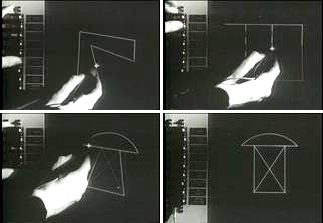This 1963 article explains the sketchpad software developed by Ivan E. Sutherland. Sketchpad is considered to be the first graphical user interface (GUI) allowing users to draw in the draw and model without using numbers or code. This software introduced a new language of man-machine interaction through the use visual geometry. Sketchpad used line, point and circle graphic primitives to produce a vocabulary of shapes. This elements could be arranged in the screen and manipulated in real time. Additionally, sketchpad could be used to work under constraints such as parallel and perpendicular relationships between elements. Sketchpad also pioneered in the concept of object oriented programming by defining graphical objects in terms of constraints. The article explains how the user creates objects with the aid of a light pen, screen and buttons. Sutherland explains that computer modeling can aid the design process in highly repetitive drawings, for example in the creation of patterns. Each object can be stored and reused to create modularity. The memory space can be used to store graphics, constraints and subroutines (functions) allowing the users to create complex relationships between these elements. The screen is used as a coordinate system that allows the user to add line segments, points and circles in it. The screen as a ‘canvas’ where the user can draw, however, the drawing is scalable to up to seven miles. The light-pen/screen interface have a snapping feature similar to the one of photoshop allowing points of the shapes to connect. The generalized geometric functions and constraints prove very powerful to create a wide variety of graphics. Sketchpad could also be used to create animations in a computer, making it the first tool for computer animation.
Sketchpad introduced visual programming and object-oriented programming, one of the most important features of computing to our days. This shows evidence that visualization can create advances in computer programming, an that not only limited to the constraints of prestablished computer languages. Sketchpad introduced the concept of recursive drawing and it was one of its main contributions. However, the skechpad had limitations in the creation of simple drawings. In the words of Sutherland:
“For highly repetitive drawings or drawings where accuracy is required, sketchpad is sufficiently faster than conventional techniques to be worthwhile. For drawings which merely communicate with shops, it is probably better to use conventional paper and pencil” (Sutherland, 1963, p. 122).
The author also envisioned an artistic use of his software suggesting it’s potential to create animated cartoons. Sutherland proposes that future uses of sketchpad include three-dimensional drawing, since the “drawing will be directly in three dimensions from the start. No two dimensional data will be stored” (p.125). The three dimensional application was rapidly implemented changing the course of computing and opening to the new discipline of computer graphics.
Article retrieved from: Sutherland, I. (1963). Sketchpad: A man machine graphical communication system. The New media Reader pp.111-126.

